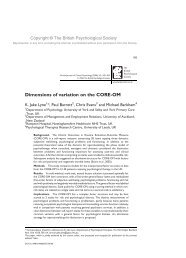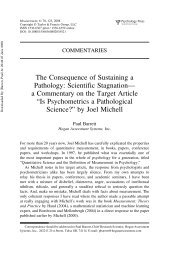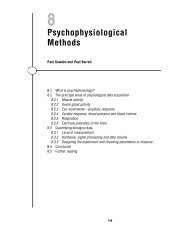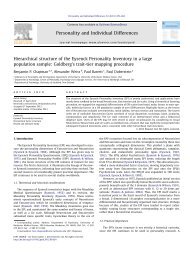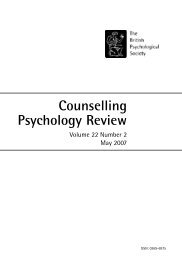Here - Paul Barrett
Here - Paul Barrett
Here - Paul Barrett
You also want an ePaper? Increase the reach of your titles
YUMPU automatically turns print PDFs into web optimized ePapers that Google loves.
Theories of MeasurementConjoint Measurement relates to situations ofthe kind:P=A+X orP=A×X (which can be represented logarithmicallyas an additive concatenation function).Its application is specifically for those instanceswhere none of P, A, or X is already quantified.It requires that: Theories of MeasurementThe Conjoint Measurement Requirements1. Variable P possesses an infinite number of values2. P=f (A,X) (where f is some mathematical function)3. There is a simple order, ≥ , upon the values of P4. Values of A and X can be identified (i.e. thatobjects may be classified according to the value of Aand X they possess).Such a system satisfying 1-4 is a conjoint system.MGMT 740 – 857th March 2006 MGMT 740 – 858th March 2006 Meaning, Theory, and MeasurementPhenomena: “relatively stable, recurrent generalfeatures of the world that we seek to explain …Phenomena comprise a varied ontological bagthat includes objects, states, processes, events,and other features that are hard to classify…“Phenomena, not data, are the proper objects ofscientific explanation; it is Phenomena that givescientific explanations their point” (Brian Haig,2002).Data: “idiosyncratic, ephemeral, and pliable, andserve as observable evidence for phenomena”. Meaning, Theory, and MeasurementThe detection of phenomena can be by anymeans – from simple qualitative observation,probabilistic modelling, experimentation,multivariate statistics, or simple counts. All thatis required in this process or detection arestandards of reproducibility (replicability).It is from data that we extract or “detect” phenomenaMGMT 740 – 859th March 2006 MGMT 740 – 860th March 2006



